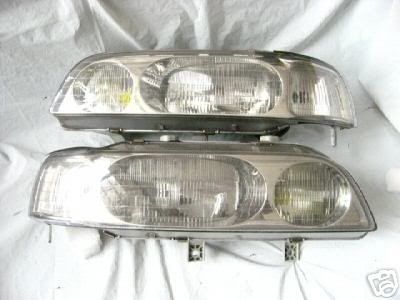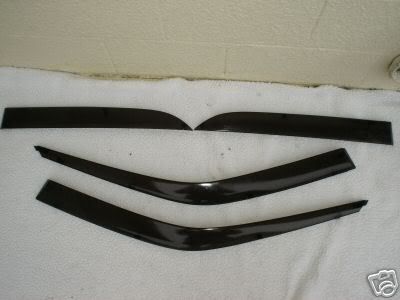While working on a build outline for Project Legend (more on that later...) I was doing my best to carefully explain the differences between Aero-parts and Body kits and was having some problems. I've been busy with school, work, gf, and family stuff as of late but recently came across an article that does an excellent job of explaining what I could not. So I thought I'd post it. The article is written by BEN SCHAFFER for Modified Magazine and can be seen if you click on this link....
http://www.therealjdm.com/archives/TheRealJDM03.pdf
Or you can just read it below, as I've taken the liberty of copy-pasting it to this blog.....
"AMERICANS are well known for their innovation and style. Our penchant for launching new trends can be quite apparent in what Japanese refer to as “spo-com”. Americans took Japanese tuning parts and techniques and transformed them into our own unique style. Without a doubt, the power of our persuasive trendsetting can be attributed to Hollywood which successfully exported the blockbuster, The Fast and The Furious to Japan using a new JDM title, Wild Speed. We effectively took Japanese culture, Americanized it and sold it back to them. Spo-com is a rapidly growing trend in Japan. Many youthful Japanese embrace American spo-com style just as passionately as we emulate Japanese tuning styles. In Japan, spo-com has had a minimal overlap in the performance tuning market.
Currently in Japan performance tuners and spo-com tuners are still considerably segregated. During my last visit to Japan, I was intrigued by a recurring theme in my discussions with various aero parts company executives. They were all surprised by the American market’s desire to mix and match aero parts while in Japan enthusiasts who buy high-end aero parts typically buy the complete kit as a functional system. I’ve been reflecting on why the two markets have such different uses for the same parts. One of the driving factors is that Americans want a unique look for their cars and in doing so they don’t want to be limited to a particular brand. Yet, aero parts from brands like C-West, Ings+1, and J’s Racing are designed as a complete system with maximum performance in mind. Real data is used to fine-tune each component so that they work in unison. When using only a fraction of a complete aero system, as spo-com tuners often do, a car’s aerodynamics will not function as the engineers intended and performance gains may be diminished. Is the difference between spo-com and Japanese style tuning due to different philosophies; perhaps that spo-com is based on image before performance and Japanese tuning based on performance before image? Evaluating terminology may offer insight on the difference of the car cultures: Americans often refer to these products as body kits while Japanese refer to them as aero parts. Or the difference in thought is simply because the average American enthusiast is uninformed on the background of Japanese performance aero products and the functional benefits.
Regardless of reason, the aforementioned executives have a valid perspective. The brands mentioned above, as well as many others, are well known in Japan for their functionality. The functionality of their designs is a result of extensive
development in a Japanese race series titled Super Taikyu. Simply put, Super Taikyu is essentially a street car version of the JGTC. Like most race series, Super Taikyu has a significant number of rules and regulations. Cars are classed in a method that keeps them very similar in power and weight, meaning that aerodynamics plays a key role in the success of each entrant. Super Taikyu is fun to watch because the aero parts and wheels on the cars are often the exact same as cars you see on the street. For example, the Asano Racing DC5 Integra competing in Class 4 uses a N-Spec Ings+1 aero kit which is available to the public. There are also three Honda S2000s with J’s Racing Type S aero parts that are also available for use on street cars. C-West aero parts find their way onto multiple Super Taikyu cars as well. It could be argued that the reason Japanese made aero parts are superior to American made aero parts for Japanese cars is because many Japanese companies use Super Taikyu as a test bed for development. Companies in America are capable of producing the same products with the same technology, but without a popular race series like Super Taikyu to give incentive, it’s rare that a US brand will create innovative aero parts for your Japanese sports car.
Rather than speaking subjectively on the matter, factual test data has been collected by News Publishing in Japan. The publications HyperRev and RevSpeed offer hard facts to convey the effectiveness of various Japanese aero parts. For example, C-West’s FD3S RX-7 is well-documented in HyperRev volume 91. The book provides detailed documentation of wind tunnel testing on the C-West N1 spec aero parts. They discovered that the C-West aero parts offered a 13.62 percent increase in downforce, and a 131.17 percent decrease in lift compared to a stock bodied car. Outside of the wind tunnel on the Tsukuba circuit, they tested the same car with astonishing results. The RX-7 posted a 1:07.39-second lap using stock body panels, compared to 1:05.45 with C-West aero parts installed.
In September 2003, RevSpeed Magazine
performed comprehensive testing on the Ings+1 DC5 Integra. In one test they data logged the car on the MINE Circuit and did a comparison of speed with and without the Ings+1 Z-Power GT wing installed. In every sector of the circuit the wing-equipped car carried faster speeds with a maximum increase of 7 mph during one particular section.
A second test was also done comparing engine bay temperatures with and without the Ings+1 aero hood. The results showed that temperatures averaged out to be 16.2°F cooler with the aero hood installed. Cooler engine bay temperatures can add more horsepower, thus reinforcing the point that aero parts can indeed offer horsepower gains.
Even in the case of simply installing a set of front canards, performance gains can be quite significant. Garage Defend produces a set of twin carbon canards they call Stingray. When tested on the Central Circuit in the wet with
a mildly tuned Honda S2000, installation of the Stingray canards alone resulted in a lap time reduction from 1:51.74 to 1:50.40. This can be directly attributed to the increased downforce over the front wheels, which in turn reduced understeer while improving turn in grip into corners.
Naturally not every driver using functional aero parts will see equivalent lap time reductions. The final result depends on how well the car is driven. Additional downforce is only important if you drive your car fast enough to actually utilize and benefit from the extra traction it provides. Aerodynamic upgrades are not beneficial for everyone, but those who push their cars to the limit should seriously consider functional aerodynamics. For enthusiasts who are less concerned with maximum performance and prefer a highly personalized image for their car, the spo-com style of mix and match customizing cultivates creativity that surpasses the inherent limitations of performance tuning. Members of both tuning religions have one significant common bond, they are all equally proud that the cars they build are a real life representation of their dreams."


